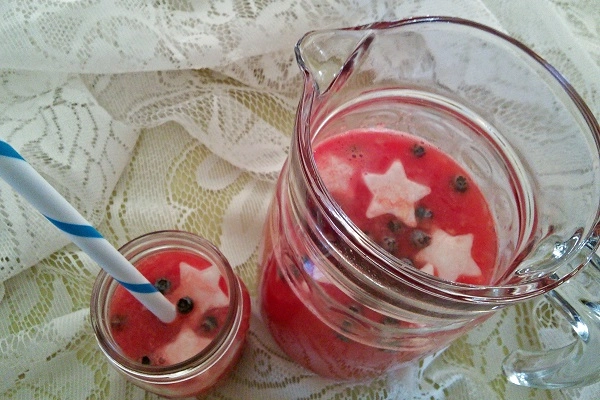Create a safe, healthy and colorful picnic


“Eat, drink and be berry” to celebrate July 4. Here’s a healthy drink of watermelon juice and blueberries with white ice cubes. First, make sure your picnic is safe with these helpful tips.
Be a smart packer
-
Picnic baskets are charming, but your food risks spoiling in the back of your car. Store food at 40 degrees or below.
-
Consider packing meat, poultry and seafood while still frozen so they stay colder longer.
-
Pack perishable foods in a cooler separate from beverages so they aren’t exposed as often to warm outdoor temperatures (all that opening and closing to reach for drinks!)
-
Keep hot foods at or above 140 degrees in an insulated container until serving.
Don’t let food linger
-
On an average temperature day, toss foods (warm or cold) that have been sitting longer than two hours — or one hour if it’s 90 degrees.
-
High risk foods include meats, salads with macaroni, rice, potato and coleslaw; even watermelon can grow E. coli and make you sick.
-
Set a meal time. Don’t graze during your picnic activities — and put lids on immediately, even if you go back for seconds!
Use airtight containers
-
Airtight glass containers keep food moist, or from getting soggy and absorbing odors. Choose tight-fitting lids that don’t allow air in after closing.
-
Use plastic containers with lids that lock, especially for dry products.
-
Avoid ceramic containers; they’re porous, so air can get in.
-
To save space, use rectangular containers.
Fool the bugs and bees
-
At home, plant citronella and other bug repelling plants next to your patio.
-
Disperse citrus peels from oranges or lemons, and mint — or spray mouthwash — around your picnic to discourage pests.
-
Block ants by making a boundary of cornstarch around your picnic area.
-
Toss sage sprigs into your campfire.
-
Use a neutral blanket or tablecloth, and wear plain attire. Bright colors attract insects, including bees.
-
Cover food with new shower caps, dome-shaped covers or foil. This prevents insects from bringing germs and leaving their own droppings.
Wash hands
-
If using sunscreen or repellant, wash your hands before eating.
-
Locate near a faucet or carry hand wipes or hand sanitizer before prepping or eating food.
Yes, you can swim after you eat
-
If you swim for fun, it’s okay to splash in right after eating.
-
If you’re exercising, wait an hour to allow food to pass through your stomach. While digestion diverts circulation away from the muscles, you have more than enough oxygen to supply your stomach and muscles. In fact, an episode of drowning caused by swimming on a full stomach has never been documented.
Avoid alcohol if swimming or boating
-
Swimming after drinking alcohol can be deadly. It causes slowed reaction times, lack of coordination, and spasms in the vocal cord that can lock the airway closed if water enters the windpipe.
-
The Oregon State Marine Board reports alcohol is involved in 30 percent of boating fatalities.
Now for the color: Patriotic sangria
This non-alcoholic sangria will impress everyone on July 4 with its splash of red, white frozen stars and blueberries. Good source of vitamin C, not too sweet, low calorie. Don’t worry about this one spoiling. It won’t last long enough.
Ingredients
1 seedless watermelon
2 lemons
1/2 cup blueberries
1/2 cup coconut milk (the kind you drink)
Instructions
Freeze coconut milk in an ice cube tray. We used one that makes star shapes.
Wash the outside of the melon and the lemons thoroughly. (Bacteria from the outside can be transferred to the inside if produce is unwashed.)
Cut melon in half. Scoop insides into a blender and puree. With cheesecloth, strain the juice into a container of your choice. Juice the lemons and add the juice to the pitcher. Before serving, add in the blueberries and your coconut milk ice cubes.
This recipe will separate over time so drink up or be prepared to stir.